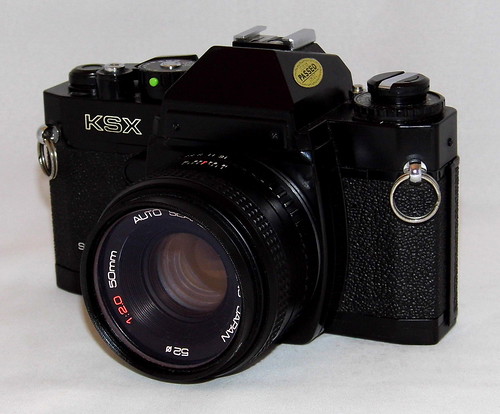Difference between revisions of "Sears KSX"
m (typo) |
m (Bolded name) |
||
| (3 intermediate revisions by 2 users not shown) | |||
| Line 1: | Line 1: | ||
| − | |||
{{Flickr_image | {{Flickr_image | ||
|image_source= https://www.flickr.com/photos/51764518@N02/35090880753/in/pool-camerawiki/ | |image_source= https://www.flickr.com/photos/51764518@N02/35090880753/in/pool-camerawiki/ | ||
| Line 10: | Line 9: | ||
'''''Note''': this article describes the first Sears KSX model; the KSX-P, KSX 1000, and KSX Super are all different cameras.'' | '''''Note''': this article describes the first Sears KSX model; the KSX-P, KSX 1000, and KSX Super are all different cameras.'' | ||
| − | The KSX was an [[SLR]] introduced by US retailer [[Sears]] in their 1980 Fall/Winter catalog.<ref>The KSX is shown on [https://christmas.musetechnical.com/ShowCatalogPage/1980-Sears-Fall-Winter-Catalog/1312 catalog page 1312] from [https://christmas.musetechnical.com/ Musetechnical's "Christmas Catalogs & Holiday Wishbooks."]</ref> This replaced the [[Sears KS 1000 | KS 1000]] as the mid-price option in the catalog; but despite a new price of USD $186.50 being $68 cheaper, this model added aperture-priority autoexposure. (The remaining all-manual [[Sears KS 500 | KS 500]] also received a price drop.) The KSX's electronically-timed shutter does require power from two silver-oxide button cells to operate (type S76, 357, or SR44). | + | The '''KSX''' was an [[SLR]] introduced by US retailer [[Sears]] in their 1980 Fall/Winter catalog.<ref>The KSX is shown on [https://christmas.musetechnical.com/ShowCatalogPage/1980-Sears-Fall-Winter-Catalog/1312 catalog page 1312] from [https://christmas.musetechnical.com/ Musetechnical's "Christmas Catalogs & Holiday Wishbooks."]</ref> This replaced the [[Sears KS 1000 | KS 1000]] as the mid-price option in the catalog; but despite a new price of USD $186.50 being $68 cheaper, this model added aperture-priority autoexposure. (The remaining all-manual [[Sears KS 500 | KS 500]] also received a price drop.) The KSX's electronically-timed shutter does require power from two silver-oxide button cells to operate (type S76, 357, or SR44). |
As with other Sears [[K mount lenses | K-mount]] cameras, it is a rebadged [[Ricoh]], specifically the [[Ricoh KR-10 | KR-10 (no suffix)]]. | As with other Sears [[K mount lenses | K-mount]] cameras, it is a rebadged [[Ricoh]], specifically the [[Ricoh KR-10 | KR-10 (no suffix)]]. | ||
| − | A | + | A number of features were cut down to meet the new price point: The standard lens is f/2.0, rather than f/1.7. There is no depth-of-field preview button, nor the viewfinder peepsight to give a direct view of the aperture-ring setting. (Both positions are somewhat inelegantly blanked out by plain covers.) There is no eyepiece blind lever (a plastic cap was supplied) nor [[multiple exposure]] button. The viewfinder indicator of the selected shutter speed remains, and is used for match-needle light metering when selecting shutter speeds manually. The camera's film advance lever must be pulled outwards to unlock the shutter release and activate the meter. |
The [[Sears KSX Super | updated KSX Super]] improves on a few of this model's features, but loses the mechanical 1/90th second X-[[flash sync |sync]] speed which can operate without battery power. | The [[Sears KSX Super | updated KSX Super]] improves on a few of this model's features, but loses the mechanical 1/90th second X-[[flash sync |sync]] speed which can operate without battery power. | ||
| Line 24: | Line 23: | ||
*See the [https://www.cameramanuals.org/sears/sears_ksx.pdf owners manual online (PDF)] from Mike Butkus' [https://www.butkus.org/chinon/ OrphanCameras.com] | *See the [https://www.cameramanuals.org/sears/sears_ksx.pdf owners manual online (PDF)] from Mike Butkus' [https://www.butkus.org/chinon/ OrphanCameras.com] | ||
| + | *For comparison, OrphanCameras.com also has the [https://www.butkus.org/chinon/ricoh/kr-10/kr-10.pdf Ricoh KR-10 manual] | ||
[[Category:Sears]] | [[Category:Sears]] | ||
[[Category:K mount]] | [[Category:K mount]] | ||
[[Category:Japanese 35mm SLR]] | [[Category:Japanese 35mm SLR]] | ||
| + | [[Category:K|KSX Sears]] | ||
Latest revision as of 04:45, 7 February 2024

|
| A less-expensive autoexposure SLR from Sears image by Joe Haupt (Image rights) |
Note: this article describes the first Sears KSX model; the KSX-P, KSX 1000, and KSX Super are all different cameras.
The KSX was an SLR introduced by US retailer Sears in their 1980 Fall/Winter catalog.[1] This replaced the KS 1000 as the mid-price option in the catalog; but despite a new price of USD $186.50 being $68 cheaper, this model added aperture-priority autoexposure. (The remaining all-manual KS 500 also received a price drop.) The KSX's electronically-timed shutter does require power from two silver-oxide button cells to operate (type S76, 357, or SR44).
As with other Sears K-mount cameras, it is a rebadged Ricoh, specifically the KR-10 (no suffix). A number of features were cut down to meet the new price point: The standard lens is f/2.0, rather than f/1.7. There is no depth-of-field preview button, nor the viewfinder peepsight to give a direct view of the aperture-ring setting. (Both positions are somewhat inelegantly blanked out by plain covers.) There is no eyepiece blind lever (a plastic cap was supplied) nor multiple exposure button. The viewfinder indicator of the selected shutter speed remains, and is used for match-needle light metering when selecting shutter speeds manually. The camera's film advance lever must be pulled outwards to unlock the shutter release and activate the meter.
The updated KSX Super improves on a few of this model's features, but loses the mechanical 1/90th second X-sync speed which can operate without battery power.
Notes
- ↑ The KSX is shown on catalog page 1312 from Musetechnical's "Christmas Catalogs & Holiday Wishbooks."
Links
- See the owners manual online (PDF) from Mike Butkus' OrphanCameras.com
- For comparison, OrphanCameras.com also has the Ricoh KR-10 manual